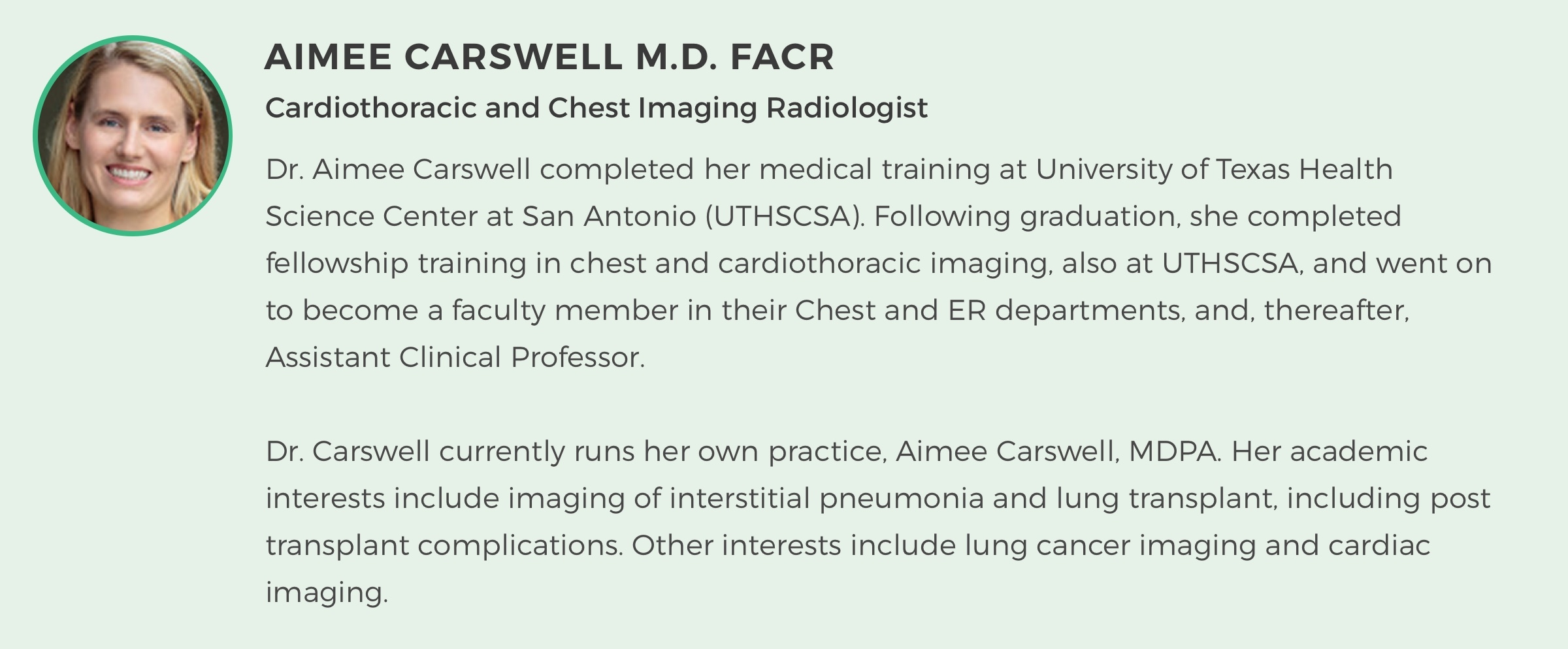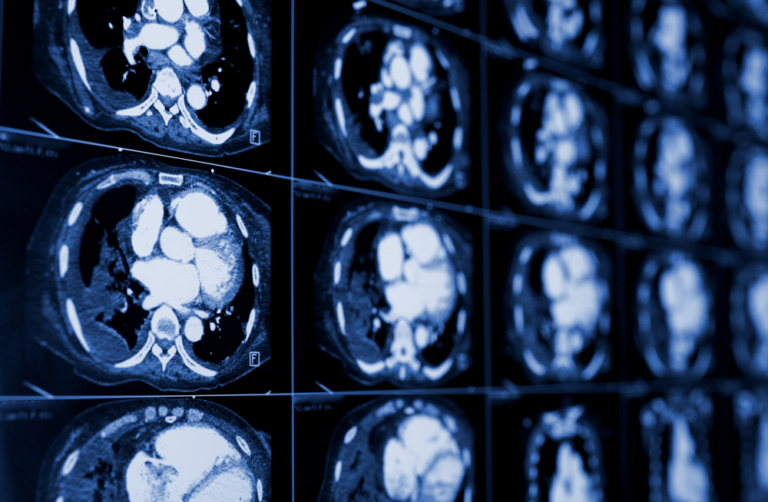Lung cancer is the most common cancer worldwide, making up almost 25% of all cancer deaths. Fortunately, advances in medical imaging hold great potential to dramatically improve lung cancer survival rates. With low-dose CT screening, early detection can decrease lung cancer mortality by 14 to 20 percent among high-risk populations. But of the 7.6 million adults who are eligible for lung cancer screening, fewer than 2% are actually getting screened.
While many factors play into this disparity, a lack of overall awareness is thought to play a part in low screening percentages among Americans. To address common questions about lung cancer screening, we spoke with expert Cardiothoracic Radiologist Dr. Aimee Carswell. From who should be getting screened to how a low dose CT scan works, Dr. Carswell explains how lung cancer is detected and staged.
DocPanel is committed to making sure every patient receives excellent care. If you would like an expert second opinion on your medical imaging scan from one of our chest & cardiac subspecialists, you can learn more here.
[DocPanel] What factors are taken into consideration when determining risk for lung cancer?
[Dr. Carswell]
Patients who are at increased risk for the development of lung cancer include those with a smoking history, exposure to asbestos, personal history or family history of lung cancer, and certain chronic lung diseases.
[DocPanel] What types of patients are advised to get annual lung cancer screening tests?
[Dr. Carswell]
The U.S. Preventive Services Task Force issued a recommendation in favor of annual screening for lung cancer with LDCT in persons at high risk for lung cancer based on age and smoking history.
Medicare will cover LDCT lung cancer screening once per year for patients: 55-77 years old who currently smoke or have quit in the last 15 years; at least 30 pack year smoking history; do not currently have signs/symptoms of cancer; and have a prescription from a medical provider.
[DocPanel] What are the benefits/advantages of a low dose CT scan when compared to other types of lung cancer screening tests?
[Dr. Carswell]
A low dose CT scan is painless and noninvasive. The scan is fast, so those with lung disease or difficulty holding their breath usually do fine. Another advantage of low dose CT (LDCT) is that it can detect very small lung nodules. This helps doctors detect cancer early when it’s easiest to treat. Because of the low dose technique, LDCT uses up to 90% less radiation than a standard CT chest.
[DocPanel] What are radiologists looking for when they review a low dose CT scan of the lungs?
[Dr. Carswell]
An LDCT shows the radiologist the lungs, as well as the heart and other soft tissues within the chest and the chest wall. If a lung nodule is found, further evaluation may be necessary depending on size and other nodule characteristics.
[DocPanel] Are benign lung nodules common? Can they be left alone or do they require intervention?
[Dr. Carswell]
Lung nodules are very common. Oftentimes, they are benign and are not worrisome. Depending on the size and appearance of the nodule (i.e. round versus spiculated) and any other associated findings, the radiologist may recommend that the nodule be followed with regular low dose CT scans, or they may recommend immediate further evaluation, such as a biopsy or a PET/CT scan. The recommendations will be written at the end of a patient’s LDCT report.
CONNECT WITH A SPECIALIST
Take Charge of Your Health
Get a second opinion from a radiology specialist in 3 easy steps.
[DocPanel] How do you differentiate between benign and malignant lung nodules?
[Dr. Carswell]
Smaller nodules are usually less worrisome. Round nodules are also usually less worrisome. If nodules are spiculated or cause parenchymal distortion, they are more worrisome. If there are other associated findings, such as enlarged lymph nodes, there is an increased risk that the nodules may be cancerous.
[DocPanel] When lung cancer is detected, how is it staged?
[Dr. Carswell]
Lung cancer staging is based upon a TNM system. T describes the primary tumor, N describes the lymph node involvement, and M describes any metastatic disease. The primary tumor is staged based upon the size, extent, and any local invasion of the tumor. CT, PET/CT, and MRI may be used to stage a patient with lung cancer.
[DocPanel] What findings on a CT scan indicate the possibility that cancer has spread to the lungs from another part of the body?
[Dr. Carswell]
If there are multiple nodules present, it may indicate that metastatic disease is present, rather than primary lung cancer, especially if the patient has a history of primary malignancy somewhere else in the body. Additionally, if a mass or tumor is visualized in the upper abdomen, it may indicate primary cancer outside the lungs.
[DocPanel] How accurate is lung cancer screening?
[Dr. Carswell]
Before a screening exam is accepted, it must have the ability to detect disease early enough to effectively reduce the number of deaths per year from the particular disease it screens for. The National Lung Cancer Screening Trial demonstrated 15 to 20% fewer lung cancer deaths for trial participants screened with LDCT.
[DocPanel] Are there any common pitfalls in detecting lung cancer with a low dose CT scan?
[Dr. Carswell]
Pitfalls include missing or misinterpreting the findings of the LDCT. If you are concerned about this, you may consider obtaining a second opinion. Sometimes, incidental findings may be found with LDCT (such as findings in the chest or upper abdomen) that are not related to cancer but that require further evaluation. A second opinion can help provide clarity on such findings.
[DocPanel] Are there any questions patients should be sure to ask their physicians when being screened for lung cancer?
[Dr. Carswell]
Patients are encouraged to discuss any concerns they may have with their primary care providers. If a patient is a smoker or has a smoking history, I would recommend they speak with their physician about whether they are a good candidate for LDCT.

